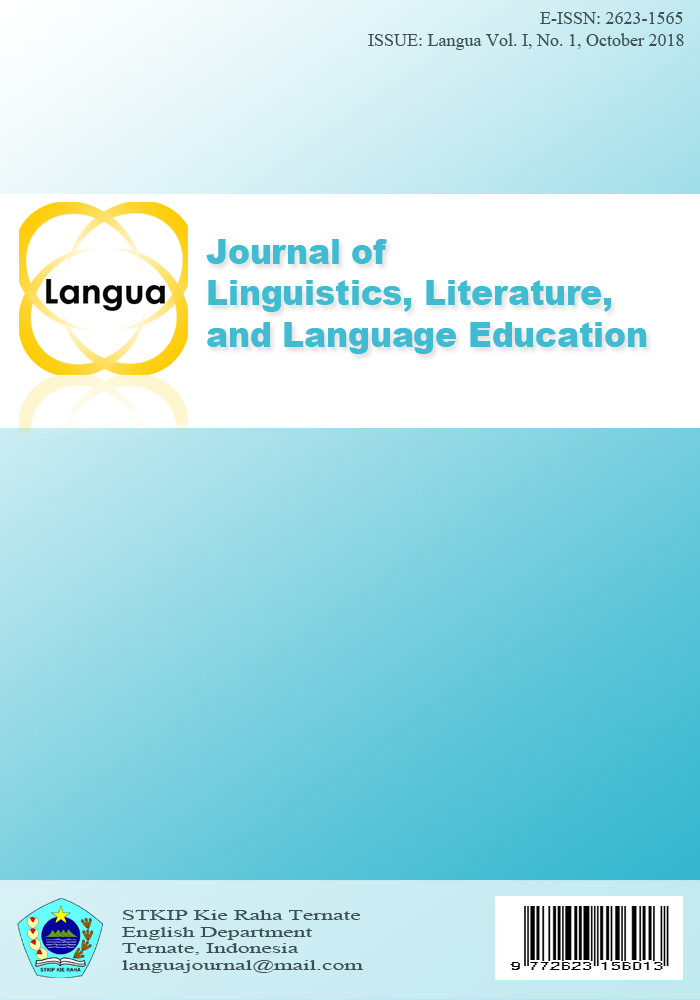Reading Comprehension: A Study on the Correlation between Grammar and Logic
Abstract
This study aims to correlate the correlation between grammar and logic in reading ability. This research is a quantitative research using ex-post facto design. The population and samples are taken from the second semester English language study program, amounting to 15 people. Data was collected using tests; there were two tests, namely grammar tests and logic tests, and questionnaires. Data were analyzed using statistics (SPSS) version 16.0. The test results show that their grammar and logic correlation coefficients are -0,028 at a significant level of 0.922. This means that the two variables have a negative correlation, because the value of the result of the correlation between grammar and logic is -0.028 which means <0.05. There is a correlation between grammar and logic, but the negative correlation means that the student's grammar value is higher than the logic value.
Downloads
References
Duke, N. (2003, March 7). Comprehension Instruction for Informational Text. Presentation at the annual meeting of the Michigan Reading Association, Grand Rapids, MI.
Fountas, I. C., & Pinnell. G. S. (1996). Guided Reading: Good First Teaching for All Children. Portsmith: Heinemann.
Grounland (1984). The Psychology of Line Up Identifications Journal of applied social psychology https://doi.org/10.1111/J.1559-1984.tb02223.X
Harmer, J. (1987). Teaching and Learning Grammar. The University of California.
Keene, E.O., & Zimmermann, S. (1997). Mosaic of Thought: The Power of Comprehension Strategy Instruction (2nded). The University of Arkansas Press, www.uapress.com.
Leech, G., and Svartvik, J. (1973). A Grammar of Contemporary English. London: Longman Group, New York: Seminar Press.
Osterlind, S. J. (1999). Reviewed Work: Multiple choices, Constructed, Response, Performance and other Format. National Council on Measurement in Education.
RAND Reading Study Group (2002). Reading for understanding: Toward a research and development program in reading comprehension. Santa Monica, CA: Office of Education Research and Improvement.
Sheridan, E.M., (1981) Theories of Reading and Implication for Teacher.The Berkeley Electronic Press.
Sudaryono, (2013) Pengembangan Instrumen Penelitian Pendidikan. Graha Ilmu.
Sugiyono, (2011) Metode Penelitian Kuantitatif, Kualitatif dan R & B. Bandung: Alfabeta.
Authors who publish with Langua Journal of Linguistics, Literature, and Language Education agree to the following terms:
- Authors retain copyright and grant the journal right of first publication with the work simultaneously licensed under a Creative Commons Attribution License that allows others to share the work with an acknowledgement of the work's authorship and initial publication in Langua.
- Authors are able to enter into separate, additional contractual arrangements for the non-exclusive distribution of the journal's published version of the work (e.g., post it to an institutional repository or publish it in a book), with an acknowledgement of its initial publication in Langua.
- Authors are permitted and encouraged to post their work online (e.g., in institutional repositories or on their website) prior to and during the submission process, as it can lead to productive exchanges, as well as earlier and greater citation of published work.






